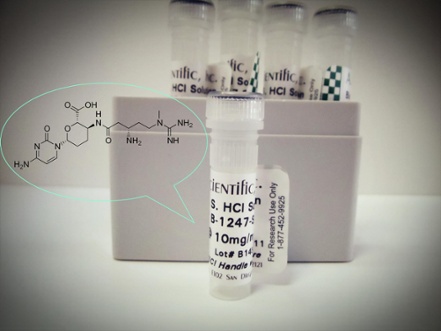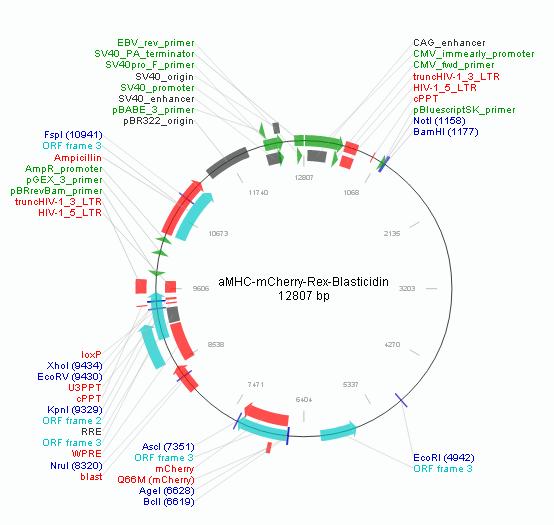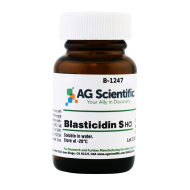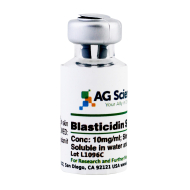Blasticidin S is an antibiotic that is produced by Streptomyces griseochromogenes. In biological research, specifically genetic engineering, it is used to select transformed cells which have been engineered to carry a resistance gene for blasticidin. In short, DNA of interest is fused to DNA encoding a resistance gene, and then is transformed into cells.
 [Blasticidin S Chemical Structure and Packaging] Blasticidin S is an antibiotic that is produced by Streptomyces griseochromogenes. In biological research, specifically genetic engineering, it is used to select transformed cells which have been engineered to carry a resistance gene for blasticidin. In short, DNA of interest is fused to DNA encoding a resistance gene, and then is transformed into cells. After allowing time for recovery and for cells to begin transcribing and translating their new DNA, blasticidin is added. Now only the cells that have the new DNA can grow.
[Blasticidin S Chemical Structure and Packaging] Blasticidin S is an antibiotic that is produced by Streptomyces griseochromogenes. In biological research, specifically genetic engineering, it is used to select transformed cells which have been engineered to carry a resistance gene for blasticidin. In short, DNA of interest is fused to DNA encoding a resistance gene, and then is transformed into cells. After allowing time for recovery and for cells to begin transcribing and translating their new DNA, blasticidin is added. Now only the cells that have the new DNA can grow.
This article contains a summary of important Blasticidin information on:
- Resistance genes
- Blasticidin selection on E.coli, Yeast, Mammalian cell, P.falciparum, Leishmania
- Toxicity to animal and human
- Laboratory tips
1. Resistance Genes
Three resistance genes have been cloned:
- bls (an acetyl transferase) from Streptoverticillum sp. which itself produces blasticidin in a natural example of biological warfare
- bsr (a blasticidin-S deaminase) from Bacillus cereus (other bsr genes are known as well, see listings in Genbank)
- BSD (another deaminase) from Aspergillus terreus
bsr and BSD are the most commonly used resistance genes. The proteins produced from these genes enable the cells carrying them to produce protein in the presence of blasticidin.
2. Blasticidin Selection
 Circular Map
Circular Map
For selection of Blasticidin-resistant E. coli, use Low Salt LB medium (10 g Tryptone, 5 g NaCl, 5 g Yeast Extract) containing 50-100 g/ml
Blasticidin. Depending on the bacterial strain used, optimize the Blasticidin concentration. If you get a lawn of bacteria on your Low Salt LB plate instead of individual bacterial colonies, increase the Blasticidin concentration to 100 g/ml in the plate.
Note that the salt concentration of the medium must remain low (<90 mM) and the pH should not exceed 7.0. Failure to lower the salt content of your LB medium results in nonselection due to Blasticidin inhibition unless a higher Blasticidin concentration is used.
The concentration of
Blasticidin required for selection in yeast varies depending on the species, strain, and type of medium used. Use 25-300 g/ml Blasticidin for selection in yeast. We recommend performing a kill curve for each species, strain, and medium used to determine the appropriate Blasticidin concentration to use for selecting resistant cells.
- Plasmodial Surface Anion Channel(PSAC) in Plasmodium falciparum
The malaria parasite,
Plasmodium falciparum, is a highly successful intracellular pathogen. In the human host, replication in erythrocytes leads to an exponentially increasing number of parasites and accounts for much of the clinical syndrome of malaria. To facilitate its rapid intracellular growth, the parasite remodels the erythrocyte cytoplasm, adds virulence factors to the surface of infected cells, and increases erythrocyte permeability to many small solutes. Increased uptake of solutes may be mediated by the plasmodial surface anion channel (PSAC).
FCB-br1 parasites resist sorbitol synchronization because they express PSAC activity with markedly lower sorbitol permeability. These mutant channels also exhibit altered selectivity for various solutes, defective gating, and reduced affinity for the inhibitor furosemide. The identification of a PSAC mutant has several important implications for intra erythrocytic malaria parasite biology.
3. Toxicity of Blasticidin S to animals
- Acute and Chronic Toxicity
In general, blasticidin S is rather toxic to mammals but has low toxicity to fish. Acute toxicity data for several species are listed in Table as follows. (some reports fail to specify whether the material tested was the free base of blasticidin S or its BABS salt, which could explain the variations in the reported LD50 values.
In rats given blasticidin S orally at 3 mg/kg or higher, alkaline
phosphatase activity in serum and small intestine was temporarily reduced.
The main pathological findings of
blasticidin S poisoning in animals occur on the mucous membrane and skin. Upon topical application, confunctivitis, keratitis, nasal bleeding, and skin lesions, including hyperemia, edema, nd ulceration, are observed. Peritoneal adhesion involving intraabdominal organs and occational gastrointestinal perforation are thought to be due to the lesions on the mucous membrane. Diarrhea is frequent and considered to be caused by irritation of the mucous membrane.
4. Laboratory Tip
Determining Blasticidin Sensitivity
1. Plate cells at approximately 25% confluence. Prepare a set of 6 plates. Allow cells to adhere overnight.
2. The next day, substitute culture medium with medium containing varying concentrations of Blasticidin (e.g. 0, 2, 4, 6, 8, 10 µg/ml Blasticidin).
3. Replenish the selective media every 3-4 days, and observe the percentage of surviving cells.
4. Determine the appropriate concentration of
Blasticidin that kills the cells within 10-14 days after addition of the antibiotic.
SOURCES:
1.Lifetechnologies
2.Handbook of Pesticide Toxicology, Vol 1, p.145
3.
www.agscientific.com
4.
www.wikipedia.com/blasticidinS
5. www.blasticidin.com
6. David A. Hill, Ajay D. Pillai, etc., A blasticidin S-resistant Plasmodium falciparum mutant with a defective plasmodial surface anion channel, 2007, vol.104, no. 3 1063-1068
7. Sophie Goyard, Stephen M. Beverley, Blasticidin resistance: a new independent marker for stable transfection of Leishmania, 2000, 249-252
[Blasticidin S Chemical Structure and Packaging] Blasticidin S is an antibiotic that is produced by Streptomyces griseochromogenes. In biological research, specifically genetic engineering, it is used to select transformed cells which have been engineered to carry a resistance gene for blasticidin. In short, DNA of interest is fused to DNA encoding a resistance gene, and then is transformed into cells. After allowing time for recovery and for cells to begin transcribing and translating their new DNA, blasticidin is added. Now only the cells that have the new DNA can grow.
 Circular Map
Circular Map
